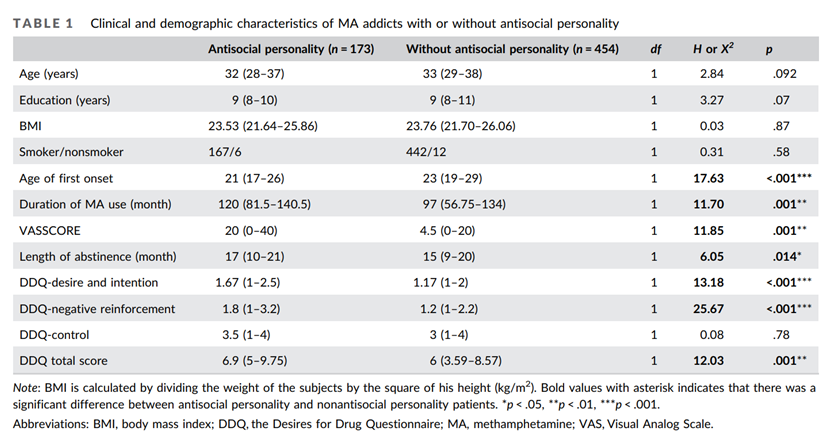Antisocial personality disorder (ASPD) is a common adult psychiatric disorder characterized by low self-control, lack of empathy, disregard for others, and high levels of impulsivity and aggression. Many studies have shown that ASPD is one of the most common co-occurring disorders in patients with drug addiction and is a predictor of many drug addictions. For example, among heroin addicts, who have a high prevalence of ASPD, factors such as education, age at first drug use, withdrawal time, and daily dose are predictors of ASPD. However, the prevalence and clinical correlates of ASPD among methamphetamine (MA) patients are unknown.
To address this issue, Professor ZHANG Xiangyang's group at the Key Laboratory of Mental Health, Institute of Psychology, Chinese Academy of Sciences, recruited 627 male MA patients to assess the prevalence and correlates of ASPD among MA patients.
The subjects recruited were MA patients over 18 years old who have no mixture use of other drugs, meeting the diagnostic criteria based on the Chinese version of the DSM-V, are not color blind, have no major medical conditions and more than 6 years of education level.
The study used a cross-sectional design to collect the demographic information of the subjects. Information such as age, education level, substance use history, medical and psychological status, BMI was collected by one-to-one questioning. After this, the study used the Mini International Neuropsychiatric Interview (M.I.N.I.), a brief structured diagnostic interview to identify patients with ASPD. Finally, two questionnaires were used to measure direct drug craving. The Drug Craving Questionnaire (DDQ) has three factors: desire and intention, negative reinforcement and control. The Visual Analogue Scale (VAS) was a pain rating scale based on the self-report symptom measures.
As the data were non-normal, Kruskal-Wallis H nonparametric test and binary stepwise logistic regression analysis were used for statistical analysis.
The results of the study showed that the prevalence of ASPD among Chinese male MA patients was 27.59%. Compared to non-ASPD subjects, patients with ASPD were younger when they first used drugs, had a longer period of abstinence and use, and had higher drug cravings and intentions, negative reinforcement, total DDQ scores, and VAS. Further logistic regression analysis revealed that age, age at first drug use, time to abstinence and negative reinforcement scores were factors associated with ASPD in MA patients. These findings remind us that we should pay attention to MA patients with ASPD earlier and provide early treatment and intervention whenever possible.

Image by LI Yuqing.

Image by LI YuLI Yuqing.
This study was supported by the National Program on Brain Science and Brain-like Intelligence Technology of China, the National Natural Science Foundation of China, International Partnership Program of Chinese Academy of Sciences, and the Key Laboratory of Mental Health of the Chinese Academy of Sciences. The study has been published in the American Journal of Addiction.
LIU Chen
Institute of Psychology
Chinese Academy of Sciences
Beijing 100101, China.
E-mail: liuc@psych.ac.cn
